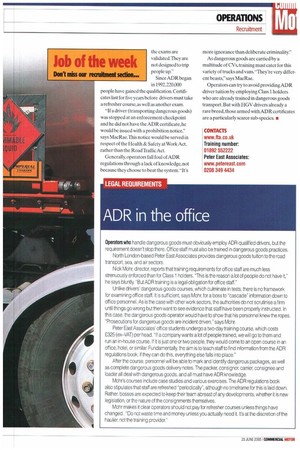Planning to diversify into dangerous goods? Then you'll need to arm your drivers with ADR
Page 66

Page 67

If you've noticed an error in this article please click here to report it so we can fix it.
training. Tim Maughan reports.
If you're a general haulage operator who plans to transport dangerous goods you must have ADR cover. Importantly, though, you don't have to pull scores of tankers before you need ADR-trained personnel—even small consignments of dangerous goods will necessitate employing fully qualified drivers Chris MacRae, the ETA's training manager. dangerous goods, explains. "If someone is carrying drums of diesel,ADR would apply if they were carrying more than1,000 litres, as a whole," he says.
"The threshold would be lower for petrol. If you were carrying 333 litres of petrol,then you would need ADR cover."And in the case of acid, an operator would have to have ADR-qualified drivers for consignments of just 20 litres.
An operator cannot hope to just read up on ADR principles, then pass on the information to his team. "The operator needs to go to an approved training provider:The City Sc. Guilds of London Institute approves trainers and the Dfl. then backs the courses," says MacRae.
What does the training comprise? To start with, every driver must do the core module. "This gives them the skills and knowledge to safely carry dangerous goods. It explains what the regulations are, what they apply to, and the classifications of dangerous goods. It looks at issues like loading, unloading, what safety equipment must be carried, and what to do in an accident or emergency."Trainees are instructed in first aid, the recovery position, how to control bleeding, and chemical burns and basic resuscitation techniques.
With the core module under his belt (the FTA charges £150 +VAT for the one-and-ahalf day core module training session) a driver moves on to the packaged goods and/or road tanker module.The packaged goods course lasts half a day while the tanker module is taught over a full day.
After this drivers get to grips with one or more of the nine dangerous goods classes, which include explosives, radioactives, flammable liquids, and corrosives.
Drivers learn about safe loading, carriage, and how to placard a vehicle correctly. Students' knowledge is tested with a multiple choice exam, "The pass rate is high" says MacRae. "Remember that the training and the exams are validated.They are not designed to trip people up."
Since ADR began in 1992,220,000 people have gained the qualification. Certificates last for five years before drivers must take a refresher course, as well as another exam.
"If a driver (transporting dangerous goods) was stopped at an enforcement checkpoint and he did not have the ADR certificate, he would be issued with a prohibition notice," says MacRae. This notice would be served in respect of the Health & Safety at Work Act, rather than the Road Traffic Act.
Generally, operators fall foul of ADR regulations through a lack of knowledge, not because they choose to beat the system. "It's more ignorance than deliberate criminality."
As dangerous goods are carried by a multitude of CVs, training must cater for this variety of trucks and vans."They're very different beasts," says MacRae.
Operators can try to avoid providing ADR driver tuition by employing Class 1 holders who are already trained in dangerous goods transport. But with HGV drivers already a rare breed, those armed with ADR certificates are a particularly scarce sub-species. •












































































































































































































